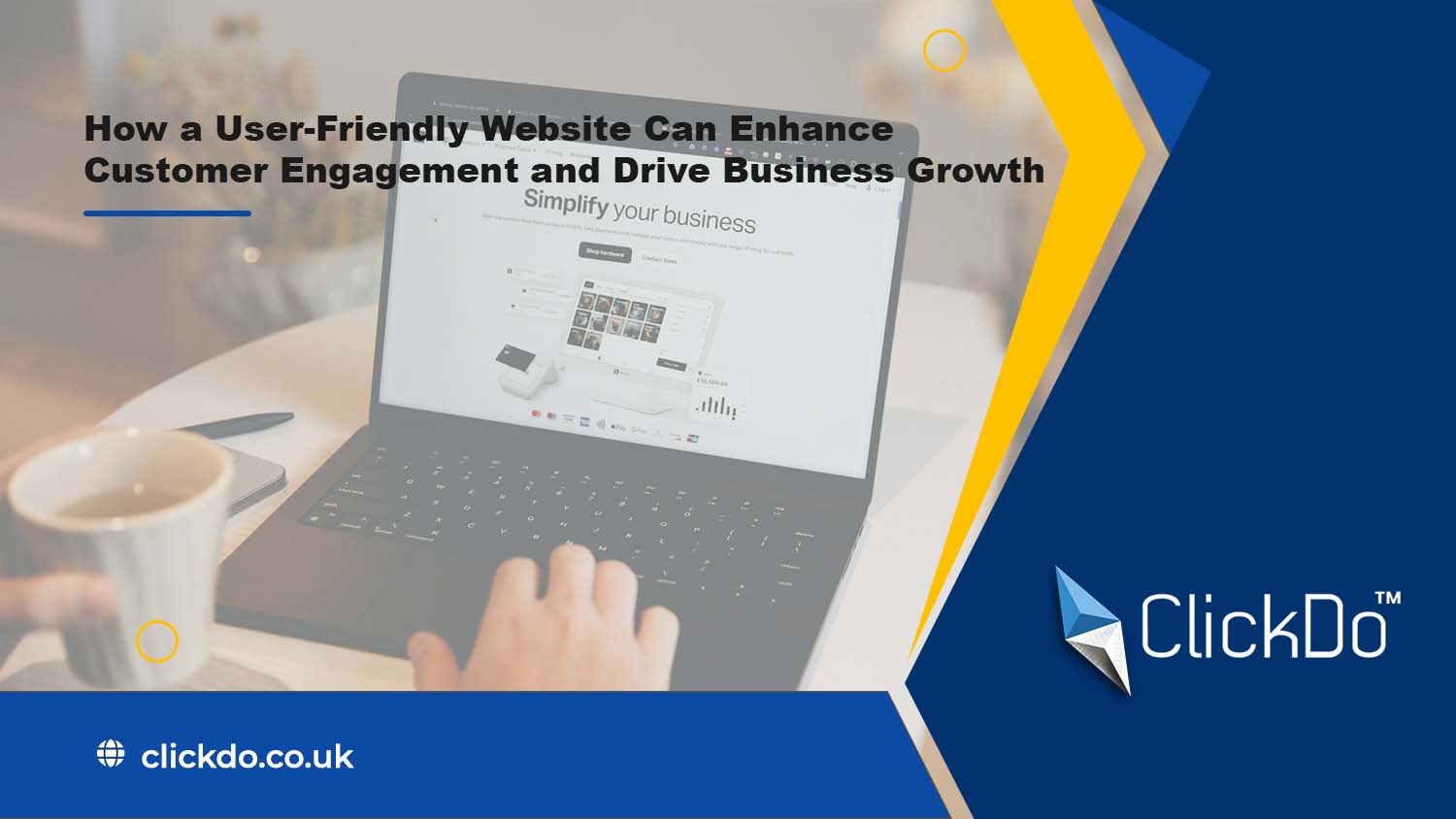
How a User-Friendly Website Can Enhance Customer Engagement and Drive Business Growth

By Manuela
In the digital age, a well-designed website is essential for any business aiming to build strong customer relationships and promote growth.
A user-friendly website plays a vital role in keeping potential customers engaged, encouraging return visits, and driving conversions. It is much more than just an aesthetic element; it directly impacts how customers interact with your brand, make purchasing decisions, and ultimately contribute to your business’s success.
A user-friendly website ensures that visitors can easily navigate the site, access information, and complete their desired actions without frustration. This streamlined experience can lead to increased customer satisfaction, trust, and loyalty, all of which are crucial for driving business growth.
Improved Customer Experience

The first and most obvious benefit of a user-friendly website is an enhanced customer experience. When a website is easy to navigate, with a clear structure and minimal distractions, customers can quickly find what they’re looking for. This positive experience increases the likelihood that visitors will stay on the site longer and return in the future.
For example, e-commerce websites, like those in the retail industry, often incorporate smooth navigation systems, intuitive search bars, and product filters to make it easier for customers to find and purchase items. By eliminating unnecessary steps and providing quick access to desired products, customers are more likely to make a purchase and become repeat buyers.
Encouraging Repeat Visits and Loyalty
A well-designed, user-friendly website encourages repeat visits, as customers are more likely to return to sites that provide an enjoyable, hassle-free experience. By fostering loyalty through loyalty programs, personalised offers, and tailored content, businesses can increase customer retention and drive long-term growth.
For example, online casinos frequently offer loyalty programs, free spins, or tailored bonuses to encourage players to return and continue gaming. This kind of personalised attention, combined with a seamless user experience, boosts customer retention rates and increases lifetime value. In particular, internationally verified and licensed non-GamStop casinos, which operate outside of the UK’s legislative framework, are known to offer unique and lucrative offers to players as they compete for business on a global scale. By offering these incentives, these casino sites are able to attract new players and keep their regular customers happy and entertained.
Retailers, too, use loyalty programs to incentivise repeat business. Offering points, discounts, or exclusive access to new products for repeat customers encourages them to keep coming back and shopping, increasing revenue over time.
Increased Customer Trust and Credibility

Trust is a cornerstone of successful online interactions, and a user-friendly website can significantly boost credibility. When customers visit a site that looks professional, operates smoothly, and is easy to navigate, they are more likely to trust the business. This trust is especially important when dealing with sensitive information such as personal details or payment information.
For example, financial services websites prioritise clear, transparent security measures and visible trust symbols such as SSL encryption, which assure customers their data is protected. By focusing on both aesthetics and functionality, these websites create an environment where customers feel secure in sharing personal information or making transactions.
Furthermore, clear and easily accessible content, such as privacy policies and terms of service, helps build trust with visitors. If customers can quickly find important information about how their data will be used and protected, they are more likely to feel comfortable interacting with the site and making purchases or inquiries.
Enhanced Engagement through Personalisation
A user-friendly website allows businesses to deliver personalised experiences that keep customers engaged. Personalisation is a powerful tool that can make customers feel valued and understood. By offering tailored content, product recommendations, and promotions, businesses can encourage customers to spend more time on the site and increase the likelihood of a sale.
This approach benefits industries like e-commerce, where retailers use customers’ browsing history to suggest related products. This personalised approach not only enhances engagement but also increases the chances of upselling or cross-selling, driving higher revenue for the business.
Mobile Optimisation and Accessibility

As more consumers rely on mobile devices to access the web, a mobile-optimised website is no longer optional. A user-friendly website should be fully responsive, ensuring that it provides an excellent experience across all devices. Slow loading times, difficult navigation, or broken layouts can lead to frustration, causing visitors to leave the site and seek alternatives.
For example, the food delivery industry has fully embraced mobile optimisation. Customers can browse menus, place orders, and track deliveries easily from their smartphones. The convenience of placing an order on the go contributes to higher customer satisfaction and encourages repeat business. Similarly, travel agencies have designed mobile-friendly booking platforms that allow customers to make hotel or flight reservations with minimal effort, enhancing the overall user experience and boosting customer loyalty.
In addition to mobile optimisation, accessibility is another key aspect of a user-friendly website. Websites that are designed to be inclusive and cater to users with disabilities improve engagement and broaden their customer base. Features like high-contrast text, alt text for images, and voice navigation options can make a website more accessible, ensuring that it’s usable for everyone.
Optimised Conversion Paths
The ultimate goal of any website is to convert visitors into customers. A user-friendly website guides users seamlessly through a defined conversion path, whether it’s making a purchase, signing up for a service, or subscribing to a newsletter. By minimising friction points and simplifying the process, businesses can increase conversion rates.
For example, in the online casino industry, websites focus on making the registration process quick and easy while offering incentives like sign-up bonuses to encourage users to take immediate action. By streamlining the sign-up process and presenting clear calls to action, online casinos can increase the chances of players completing the registration and making deposits.
Similarly, retail websites use strategic calls to action, such as “add to cart” or “proceed to checkout” buttons, to guide customers smoothly through the purchasing process. Offering additional incentives like discounts for first-time customers or free shipping further enhances conversion rates by encouraging users to take action sooner.
SEO and Increased Website Traffic

A user-friendly website is also better optimised for search engines, leading to improved visibility in search results. Google and other search engines reward websites that load quickly, provide a good user experience, and feature high-quality, relevant content. As a result, businesses with user-friendly sites are more likely to rank higher in search results, driving more organic traffic to their pages.
For example, blogging platforms use user-friendly design features to keep visitors engaged, such as clear navigation, easy-to-read text, and integrated search options. These features not only improve the experience for visitors but also contribute to higher search engine rankings, which increases website traffic over time.
Similarly, service-based websites, such as those in healthcare or consulting, use SEO techniques to ensure that potential customers can find them easily. By offering informative content, intuitive navigation, and mobile optimisation, these websites not only meet customer needs but also drive higher traffic and conversions.
Author Profile
- Blogger and Marketer by Passion | Senior Online Media & PR Strategist at ClickDo Ltd. | Contributor to many Education, Business & Lifestyle Blogs in the United Kingdom & Germany | Summer Course Student at the London School of Journalism and Course Instructor at the SeekaHost University.
Latest entries
 Web DesigningApril 22, 2025Elevate Your Online Presence: 5 Essential Web Design Elements for a Next-Level Website
Web DesigningApril 22, 2025Elevate Your Online Presence: 5 Essential Web Design Elements for a Next-Level Website BusinessApril 3, 2025How a User-Friendly Website Can Enhance Customer Engagement and Drive Business Growth
BusinessApril 3, 2025How a User-Friendly Website Can Enhance Customer Engagement and Drive Business Growth Web DesigningFebruary 24, 2025How to create a Selling Website: 8 key Elements of successful Web Design
Web DesigningFebruary 24, 2025How to create a Selling Website: 8 key Elements of successful Web Design BusinessJanuary 16, 2025What is RNG in iGaming: The Algorithms of Fair Play
BusinessJanuary 16, 2025What is RNG in iGaming: The Algorithms of Fair Play
